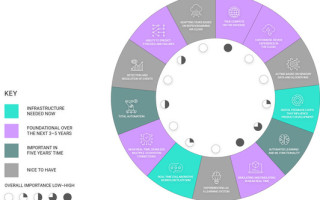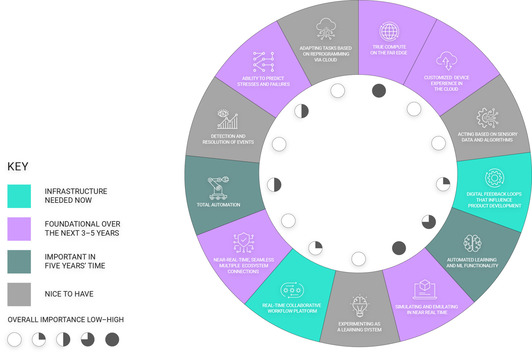AI and intelligent systems: The road to better and faster decisions in high-risk scenarios
BlogFebruary 04, 2022

The aerospace and defense sector has placed the greatest urgency on building the most complete intelligent systems now. CB Insights states, “In the aerospace and defense industry, supporting software has to make quick decisions in high-risk scenarios. Artificial intelligence [AI] is becoming integral to the $8.7 trillion space as companies and government agencies explore using technologies from robotics and autonomous systems to cybersecurity and telecommunication for national security.”
With big dollars and national security on the line and AI on the horizon, you might think we are living the plot of the next Hollywood blockbuster. But the intelligent edge is where real life and science fiction meet and innovation thrives.
70% of GDP growth in the global economy between now and 2030 will be driven by machines, according to PwC.

The rise of a new machine economy will have smart, connected, autonomous machines, and devices carry out the necessary activities of production, distribution, and operations with little or no human intervention. And this new economy will be powered by intelligent systems.
Visionary leaders in the energy and utilities world, telecommunications arena, and many other industries, including aerospace and defense, will implement new technologies and combine them with capital investments in ways that help them grow, expand, diversify, and improve lives.
State of the union for the defense and aerospace sector
It shouldn’t be news to readers that in this sector the ability to make accurate quick decisions in high-risk scenarios is critical. In addition to AI becoming an increasingly important investment, a recent Wind River study concluded that:
- 71% of the impact value of intelligent systems will be created in the next three years,
- 86% of A&D executives believe more than 50% of their embedded products/solutions will be designed to be used on the far edge, and
- while expressing an understanding of the value around intelligent systems success, only 14% believe they are both committed and succeeding at it.
The takeaway is that work needs to be done to live up to the promise that intelligent systems have to offer, but the value is there to be unlocked and in fact, our national security may depend on it.
The good news is there are best practices or what I’m calling a ‘blueprint’ for succeeding quickly.
Blueprinting for the intelligent edge future
In our data-centric world, the idea of intelligent systems is intrinsically understood but not extensively practiced. For companies in industries such as aerospace or defense, manufacturing, medical technology, energy, and telecommunications, the challenges lie in determining the right characteristics for success. The characteristics of a successful intelligent system are more than just the technologies deployed; they cover how leaders think about intelligent systems, business drivers, and deployment of the necessary process changes for embedded intelligent systems design.
In the aerospace and defense sector, the key characteristics needed now are the ability to synthesize workflows with one process for all parties involved and the use of tools such as digital feedback loops in new product and service development. This illustrates the importance of bringing people, data, and new collaborative work processes to the forefront in these organizations’ intelligent systems.
The U.S. Department of Defense has embraced DevSecOps software methodologies, and defense companies are investing to realize continuous development, deployment, and operation of complex systems responding in near real time to digital feedback loops. The commercial aviation industry equally understands this need, as it looks to bring vast arrays of near-real-time data into business operations to benefit customers and improve product and service delivery.
Based on the intelligent systems research, the two most impactful needs for five years from now are the capacity to benefit from automated learning and machine learning and the ability to deliver total automation. The AL/ML characteristic should be considered the more important of the two.
A dialog about intelligent systems for a better future
Visionary leaders in the aerospace and defense sector as well as many other industries will implement new technologies and combine them with capital investments in ways that help them grow, expand, diversify, and improve lives.
It is important for us all to continue to discuss what the future of embedded devices and solutions looks like in an intelligent systems world, the barriers to and drivers for adoption of intelligent systems, the factors that would accelerate the adoption of intelligent systems, how to best prioritize investments and what key metrics for success look like.
Specifically, in aerospace and defense many of the hardware constraints of the past are behind us and intelligent systems are here today to accelerate the realization of a new software-enabled world and a better future for humankind.

Roberto Valla is the Digital Transformation Officer, Aerospace and Defense, for Wind River






